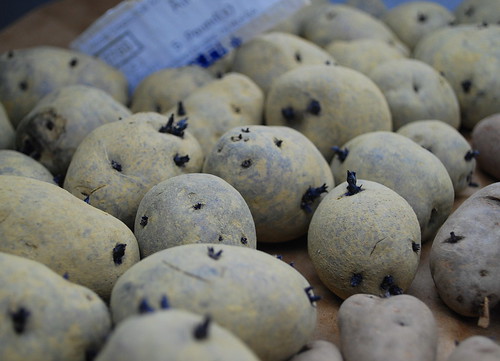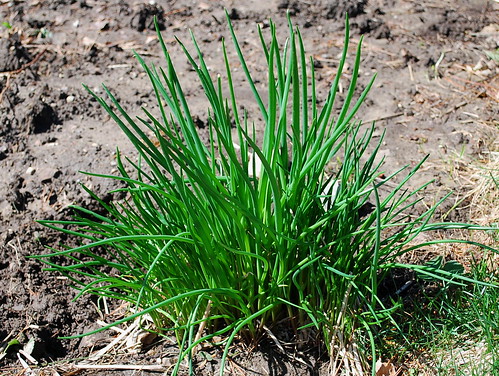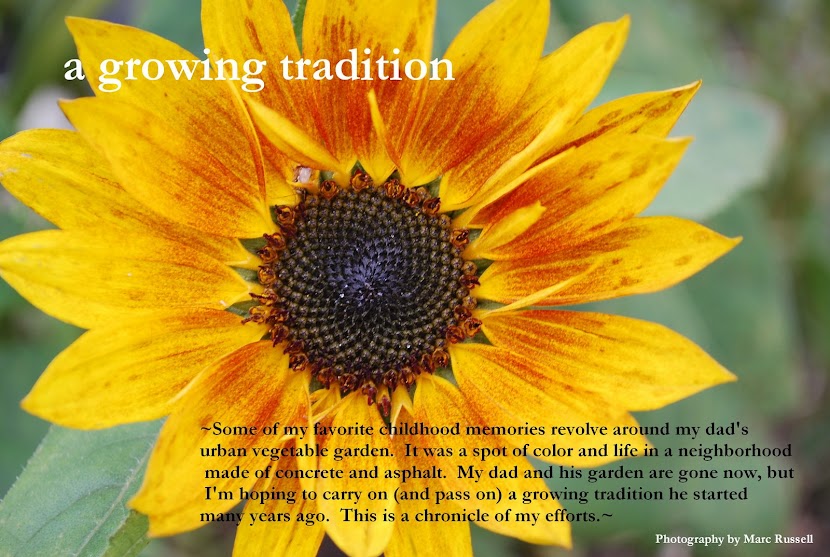
2. My seed potatoes are happily chitting away. I will plant them out very soon. I've been reading about potatoes grown using straw. Here's a good article on this very subject. Has anyone grown potatoes using this technique and if so, did it work well? I'm concerned about reduced yields and potential light exposure to the tubers.

3. Initially, I thought that these were chives growing in the old garden but now I'm starting to second-guess myself (although I did see a light purple chive-like flower last fall). The leaves just look much thicker than conventional chives. I'm wondering if this happens as the plant get older and is not harvested on a regular basis. So what do you think? Are these chives or are they some kind of perennial onion???







I have no idea about the greens. I really wanted to get some interesting potatoes (purple/red...) but didn't get around to it yet. There's still time. Not sure about the 'chives'.
ReplyDeleteI don't have one single answer to your gardening questions...I just wanted to say hello and comment on how cool those seed potatoes are! (And to thank you for the nice compliment on my photo...:-})
ReplyDeleteThomas...#3 : they appear to be chives..I have several of these and mine have gotten much thicker over the years...I think you are correct in that it is due to the maturity of the plant.
ReplyDeleteAlthough they appear to be chives, I'd be careful. We had several plants in our front lawn that had leaves like chives and roots like wild onion, but once it flowered, it turned out be completely different (grape hyacinth). However, the flower does appear very chive-like. Best of luck in positively identifying it!
ReplyDeleteBrittany
The kale is going to put all its energy into blooming and producing seeds so it won't be producing very many more leaves. Once the seeds mature it's time to pull the plants. You should read up on saving seeds of brassicas in a book such as Seed to Seed by Suzanne Ashworth. The more plants the better for brassicas, too few plants that are allowed to pollinate each other will eventually lead to poor quality plants. Plus, many different types of brassicas will cross pollinate, so your kale could cross with broccoli or any other brassica blooming in the neighborhood. Hmm, I don't mean to put you off seed saving with all this. . . I highly recommend Suzanne Ashworth's book, it's full of excellent information about saving seeds of many different vegetables.
ReplyDeleteGrowing potaotoes in straw is a excellent way to get lovely, clean potatoes. If you follow the directions, you should have a nice crop. I have done this for about 35 years and love my potato garden. Just remember to look out for slugs, if you have 'em.
ReplyDeleteYes, chives, wild onions, wild garlic all get thicker leaves as the plant matures. If you are curious as to what the plant really is, dig a few bulbs and take the whole plant, bulb, leaf, and flower to your local USDA Extension office. Better to check than to be sorry.
Susan
http://susan-chicdaisy.blogspot.com/
I've read a few negative things (the "turning green," rodents), but mostly positive about growing in straw. What sort of setup are you thinking of using with the straw? Bins? chicken wire?
ReplyDeleteNo.1
ReplyDeleteNo idea about a kale, but the picture is beautiful.
No.2
I have read few disappointing stories about growing potatoes in straw, but also a few successful ones.
Here you have Ruth Stout planting potatoes in straw:
http://www.youtube.com/watch?v=A9ReIotPNVM
It’s around 7th minute and continues in part 2.
No.3
It looks like chives to me. I would taste test few leaves. Then you would be sure.
I can't help with the first two questions, but #3 does look like chives to me. The purple flower looks like the ones that form on my own plants. Break off a leaf and give it a little sniff. It should smell like a mild onion.
ReplyDeleteI've read a lot of differing opinions about straw. A mixed way to do it is to plant the potatoes shallowly (maybe four inches) and then build up mulch with straw after they come up. The potatoes won't be as clean as in straw, but have better protection from both sun and mice and tend to still be easy to harvest. I've never done it this way though. I rarely plant potatoes.
ReplyDeleteThey look like chives. If they bloom in May with those nice lavender flowers you will know for sure. Mine get very big too. I don't cut them back much at all.
No idea on the kale because I never let it go to seed. On the potatoes, I agree with Daphne on the hybrid approach. Since we have slugs of some significance here any deep mulch method is out of the question but if your slug problem is not great then deep mulching is a great option.
ReplyDeleteI vote chives too but just give them a taste and that will confirm it.
Thomas, depending on your varieties you won't be doing all that much hilling, so an alternative is to layer some compost in along with the straw. This will help block light. That is what I will be doing this year, or I will do 1/2 and 1/2 to compare (meaning some traditional hilling). I will be using my old standby (dog hair) around the garden again and hopefully it will continue to repel all of those slugs and mice etc....
ReplyDeleteKale will be edible but flavour will change with heat.
ReplyDeletePotatoes - see email I sent ! :-)
Sure look like chives. Could be field garlic (edible), but leaves look too fat. My chives look like that. As long as the leaves are tubular, you're ok.
They look exactly like the chives in my garden bed that are a year old. Potatoes, I only do in cages with straw, and I am extremely happy with the results! I think certain varieties are probably better this way than others, but the red potatoes and Rose Finn fingerlings I did last year did well. I put a wire cage (you can use most anything!) laid the potatoes down, covered a couple of inches of compost out of the pile (again, dirt, or most anything!) and waited for them to show sprouts. Then I started piling the straw on every couple of weeks until I had cages about 3-4 feet filled with straw. When ready to harvest, I simply lifted the cage off and the potatoes come out clean and grow to nice sizes due to the extra room they get. We have terribly hot and humid summers down here so if we can do it, you should be able to. Back home in MN this is a popular Scandinavian method! Good luck!
ReplyDeleteI have no prior experience with straw-mulched potatoes, but I am trying the "mixed" method like Daphne and Kelly mentioned. I'm also planting 1/2 my potatoes using traditional hilling methods.
ReplyDeleteSure looks like chives to me, but I would think they'd be blooming soon if they are. My clumps are showing flower buds right now.
One surefire way to check if those are chives - cut and sniff! And check to see if what you cut is hollow.
ReplyDeleteThe potatoes look happy chitting away.
#1 Yes, the leaves will be pretty much worthless as it starts to form seeds.
ReplyDelete#2 I haven't tried this myself but it looks promising:
http://www.gardenfreshliving.com/2009/06/the-building-of-a-potato-condo.html
#3 Most likely chives, you could take a flower to your local ag office to make sure.
What beautiful purple-blue buds on the potatoes!
ReplyDeleteI have a sure-fire way to test your chives theory. Cut some and sprinkle it on a nearby dish of corn or potatoes with sour cream. At worst, you've added a bright note of early spring onion (shouldn't be too hot yet), and either way you've got the answer to your question. :) (I confess I did this with a wild dill lookalike last year, with sorry -- but momentary -- results.)
I say pull the kale after the it seeds and I say chives.
ReplyDeleteI just found this wonderful site about staw bale gardening, and I ordered the book. Also, there is a lot of info if you do a search on it. Sounds like a wonderful way to grow veggies, and I'm going to try it for my Florida fall garden.
ReplyDeletehttp://www.strawbalegardens.com/
Looks like chives to me. Mine have been at my house for over 13 years and are up about that high. the best way to find out is break off a piece, it will have a nice scallion-like scent. I always know when mine are out because my 10yo sneaks them from the garden. (I can always smell the onions!) When you get chive blossoms, cut some off, make sure there aren't any bugs, put them in a small jar and cover them with vinegar. let the vinegar/blossom sit for a few weeks and you'll notice it changing to a purpley color. strain the blossoms from the vinegar and use on your salad. Yum!
ReplyDeleteI'm not good when it comes to veggies and I'm just getting started. Unfortunately I can't help with your Qs but would be interested to know and learn what others say...
ReplyDeleteThanks for all of the feedback everyone! Tons of great info here.
ReplyDeleteChives. I have more than I need. Some have very thin leaves and some are very fat. Right now I mainly use them for flowers - they are beautiful and the bees love them!
ReplyDelete[url=http://hairtyson.com]buy Phen375[/url] are tablets that resist abridge confederation weight. The same of these tabs has to be enchanted with fizzy water be illogical, almost 20 minutes ahead a collation, twice a day.
ReplyDelete